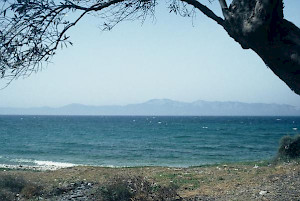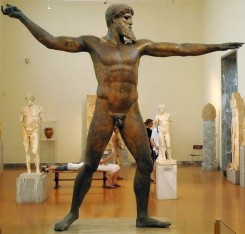Artemisium
Q1728291Artemisium (Greek Ἀρτεμίσιον): northern cape of the isle of Euboea, well known for a temple of Artemis, a statue of Zeus, and a naval battle in 480 BCE.

In Antiquity, the name "Artemisium" was given to the coast of Euboea opposite Magnesia, which is more or less the northernmost part of the island. It belonged to the town of Histiaea - "rich in vines", according to Homer.
Two locations, however, could especially claim the name: the north promontory itself and a temple of the Dawn-facing Artemis, which has been excavated a bit more to the west and appears to have been of some regional importance until it was in the sixth century CE destroyed by the Avars. In 1928, one of the most famous classical sculptures was found in the sea: a large, naked god about to throw something. It is now in the National Archaeological Museum in Athens.
The question which god is represented, has never been answered satisfactorily. The fact that it was found in the sea, has led to the hypothesis that it is Poseidon, but if the statue carried a trident, it would be asymmetrical, and the blade would be in front of the god's face, which is ugly. The alternative hypothesis is that it represents Zeus, about to smite his thunderbolt, and this seems to be confirmed by little statuettes of Zeus Keraunos that were found on several places in Greece. However, the Artemisium statue has its arm stretched, while Zeus Keraunos had the thunderbolt close to its head.
 |
 |
Cape Artemisium was the site of one of the largest naval battles in ancient history, discussed here.